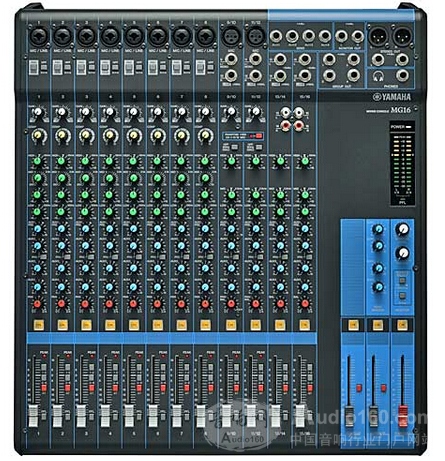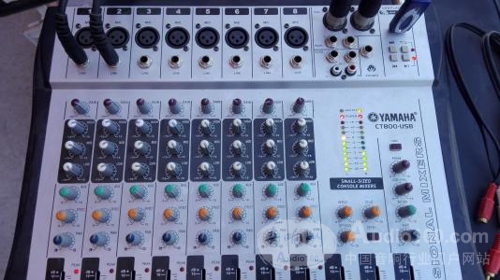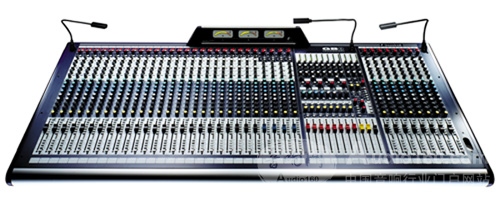At some large-scale performances, it is often seen that behind-the-scenes technicians debug the entire stage on a large number of professional equipment. This is because the audio signal generated by the microphone is very weak. Other devices output signals, such as synthesizers, audio interface output, etc., their signals are many times stronger than the microphone's signal, and their signal size is also different, jagged. We need a device to adjust these large and small sound signals to the same size in order to mix. With a set of tuning equipment that manages the entire active audio signal, a smooth transition is achieved when the singer changes frequently, which is essential for the entire event. The mixing console, also known as the tuning console, is a multi-channel input signal for amplification, mixing, distribution, sound quality modification and sound effect processing. It is a broadcast and recorded program in modern radio broadcasting, stage amplification, audio program production and other systems. Important equipment. The mixer can be divided into analog mixers and digital mixers according to the signal output method. Mixer Mixer has different aspects in terms of the number of input channels, the number of face function keys, and the output indication. In fact, to master the use of the mixer, it is necessary to examine it in general, and through practical operation and connection, natural practice makes perfect. The mixer is divided into three parts: the input part, the bus part, and the output part. The busbar section links the input section to the output section to form the entire mixer. Before using the mixer, we need to have a good understanding of the function of the mixer. The mixer is the most important equipment in the professional audio system, and a professional audio system is often based on the mixer. The commonly used mixer can accept 8~24 different signals at the same time, and adjust the processing of these signals in tone and amplitude. In general, the mixer has four main functions. However, there are several types of consoles that are subdivided. Image matrix mixers are music mixers, and musicians can create different styles of music through this matrix output. The difference between it and the general mixer is that the matrix bus is added. The various acoustic signals can be separately programmed into the matrix bus. The acoustic signals sent from the matrix bus are mixed and amplified into multiple groups. The signal size of each group can be adjusted and then mixed. The mixed signal is size-adjusted through the matrix output, isolated and amplified, and finally the matrix acoustic signal is sent. The input signal of the mixer is roughly divided into two types: low-resistance microphone signal input and high-resistance line signal input. In fact, we can regard the distinction between low resistance and high resistance as the difference between water pressure and water flow speed. Now the output section of the professional mixer has a lot of sockets, and each has a division of labor, unlike the input section, although the socket is many, it is relatively simple. Therefore, be careful when connecting the output signals. Usually, the main output part of the mixer refers to the total volume output, the grouping volume output, the AUX output, etc. In general, the output part of the mixer can be divided into six parts according to the function: 2, the main channel output: LR main channel usually uses XLR card balance output, some small mixers are also replaced with TRS stereo jack. It can be seen that the mixer is essentially a matrix, and the mixer has auxiliary functions such as monitoring, display, grouping, remote control, and intercom. The mixer can monitor each input signal or output signal separately, or selectively monitor the mixed signal to provide a basis for system tuning; the mixer has a volume meter or a digital LED indicating light column to indicate each The strength of the signal level, so that the tuner can detect the signal level visually while monitoring, to judge whether the components in the mixer work normally; there is also a communication microphone on the mixer. The interface can be connected to a moving coil microphone for the audio operator to use with the performer. When the intercom switch on the mixer is turned on, in addition to turning on the communication microphone, the other microphones are transferred from the program delivery system. Received a communication intercom system. Waveguide Load,Waveguide Dummy Load,Waveguide Termination Load,High Power Waveguide Load Chengdu Zysen Technology Co., Ltd. , https://www.zysenmw.com

Only after clearing the high resistance and low resistance can the correct wire be selected for the corresponding connection. In general, the input jacks of the mixer can be basically divided into three types:
1, TRS: high-impedance input part usually use 6.35cm TRS stereo connector for balanced input, try not to use 6.35 TS mono (sound) connector for unbalanced input, and now most of the audio playback devices we use such as: CD, The output signals of VCD, DVD, MD, MP3, etc. and most instruments are usually high impedance signals.
2, XLR: And low resistance is usually balanced input with XLR card connector, and now most wired microphones are usually connected to the mixer with a low-resistance jack.
3. RCA: If some mixers have TAPE recording input, it is usually connected with RCA lotus connector. 
1. Group output: If we separately control the volume through the 1-2 group, then we can only output the audio signal from the corresponding output jack of the mixer 1-2 group. Most of the output ports of the group output adopt TRS. Stereo jacks are used for balanced output, and of course some are used for cassette jacks. 
3, AUX output: AUX output in the mixer is most commonly used for output to vocal effects, followed by monitor signals for bands or singers, of course, for other purposes, such as: recording, used as auxiliary speakers Signals, etc. AUX typically uses a TRS stereo jack to output signals.
4, Direct direct output part: more professional mixers each input channel also has a "Direct direct output" jack, this jack can be provided to other devices for recording, monitoring, etc., usually every channel of the mixer The signal is output using the TRS stereo jack. For example, a performance TV station needs to be broadcast live, and the scene should be broadcast live. If there are 20 channels of audio signals, then we can input these 20 channels of audio signals into the mixer of the TV station first, and then use the Direct direct output in the TV station. The jack re-enters the 20-channel source signal into the mixing console of the live performance. Of course, for safety now, the 20 channels of the source signal are first adjusted and distributed through the signal amplification distributor, and then sent to the TV station mixer, live performance mixer, standby emergency mixer, recording mixer or other. Equipment, etc.
5, recording output: the general analog recording output signal socket mostly use RCA lotus joint. If it is a digital signal, it may use other digital output methods such as fiber optic and firewire.
6. INS plug-in jack: This jack in the mixer is between the input and output. It is connected by a TRS stereo connector. A lot of sound engineers may not use it for inserting and inserting INS. It can insert a peripheral device into an input channel, group channel or main (left and right channel) channel of the mixer, and separately sound signals to the inserted channel. Process it. Use TRS big three-pin stereo connector for connection by outputting the signal from the TRS big three-pin stereo plug head to the input of the device to be inserted, and then sending the signal from the output of the device to the TRS big three core The loop end of the stereo plug then flows into the mixer. For example, we can use this method to insert an equalizer into the microphones of the mixer 1 and 2, which is equivalent to cutting off the water pipes of the 1 and 2 microphones, adding a water processor (equalizer), and then inputting to The mixer makes it better to adjust the sound.